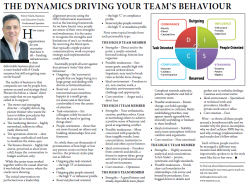Trevor Clark - The Dynamics Driving Your Team's Behaviour2018-02-23 Trevor Clark, Business and Executive Coach, Professional Speaker.
How many organisations do you encounter that have it all - funding, infrastructure, a clear, deliverable business plan and a team loaded with A-Grade resumes; but still not getting runs on the board? The reality of business is that companies are run by people first, systems second and strategy third. Picture the below, a 'classic' client case study that we are regularly called in to support:
The initial intervention we performed was a leadership alignment process using the DISC behavioural assessment tool as the learning framework. As we have found, once people are aware of their own strengths and weaknesses, it is far easier to recognise the strengths and limitations of one's co-workers. By removing the blind spots that typically cripple positive communication, work on proper strategy and implementation could follow. Essentially people all score against four primary 'states' that drive behaviour:
THE HIGH D TEAM MEMBER
Each of these people need to be managed a different way, incentivised differently and, importantly, spoken to in the style most like his or her own. To find out about behavioural assessments and training for your team, get in touch on: Tel: 031 266 2258 durban@actioncoach.com www.mastery.co.za |
Trevor Clark - The Dynamics Driving Your Team's Behaviour
Copyright © 2024 KwaZulu-Natal Top Business
